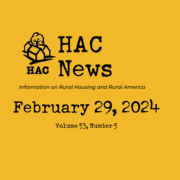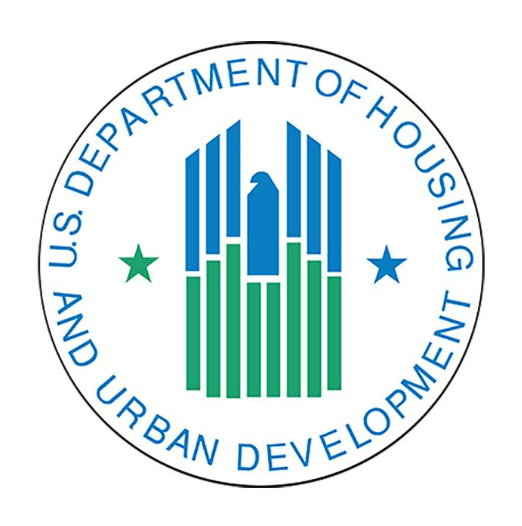HAC News: February 29, 2024
Vol. 53, No. 5
TOP STORIES
Congressional leaders agree on FY24 USDA and HUD funding
On February 28, with funding for USDA, HUD, and some other federal agencies scheduled to end at midnight on March 1, congressional leaders announced they have reached agreements on several appropriations bills, including the bills covering USDA and HUD. Congress is expected to pass another continuing resolution extending funding for these agencies to March 8 and for the rest of the government to March 22. When the text of the bills, providing the funding levels for each program, are available, HAC will update our web pages on USDA and HUD funding.
USDA Equity Commission releases final report
USDA’s Equity Commission released its final report on February 22, strongly urging USDA to prioritize and invest in housing. It offers several recommendations related to housing and community facilities programs and to the operations of the Rural Development mission area. Shonterria Charleston, HAC’s Director of Training and Technical Assistance, served on the commission’s Rural Community Economic Development Subcommittee.
Senate confirms Gooden as RD Under Secretary
On February 26, the full Senate approved President Biden’s nomination of Basil Gooden as USDA Under Secretary for Rural Development. Gooden, who has been USDA RD’s Director of State Operations since 2021, has also served in the Virginia state government’s agriculture and housing offices and as RD’s State Director for Virginia.
RuralSTAT
Over 85% of Black rural Americans reside in the Southern region of the United States. Source: Housing Assistance Council tabulations of the U.S. Census Bureau’s 2020 Redistricting Data-P.L. 94-171. To learn more about race and ethnicity in rural America visit HAC’s Taking Stock report.
OPPORTUNITIES
HUD’s new manufactured housing program opens
The Preservation and Reinvestment Initiative for Community Enhancement (PRICE) supports efforts to maintain, protect, and stabilize manufactured housing and manufactured housing communities. Eligible applicants include nonprofits, local and state governments, Tribes and Tribally Designated Housing Entities, multi-jurisdictional entities, resident-controlled manufactured housing communities, cooperatives, CDFIs, and Native CDFIs. The application process includes publishing for public comment and holding at least one public hearing. The deadline is June 5. For more information, email PRICE@HUD.gov.
Section 202 funds offered to develop supportive housing for the elderly
Nonprofits are eligible for HUD Section 202 capital advance funds to develop supportive rental housing for very low-income people age 62 or older, as well as project rental assistance contracts. The program can also support the development of intergenerational housing for elderly caregivers raising children. Applications are due June 20. For more information, email 202CapitalAdvanceNOFO@hud.gov.
ConnectHomeUSA broadband program expands further, extends deadline
Continuum of Care and Housing Opportunities for Persons with AIDS grantees are now eligible for HUD’s ConnectHomeUSA demonstration program, which is intended to accelerate broadband internet adoption and use in HUD-assisted housing. PHAs, Tribes, and owners or operators of HUD-aided rental housing remain eligible. The deadline for all applicants has been extended to April 12. For more information, contact Dina Lehmann-Kim, HUD, 202-402-2430.
ReConnect broadband program to open in March
The application period for USDA’s Rural eConnectivity (ReConnect) program will be open from March 22 through May 21. Nonprofits, for-profits, coops, and state, Tribal, territorial, or local governments are eligible for loans and grants for construction, improvement, or acquisition of facilities and equipment needed to provide broadband service. For more information, contact Laurel Leverrier, USDA, 202-720-9554.
REGULATIONS AND FEDERAL AGENCIES
Housing Trust Fund and Capital Magnet Fund amounts drop again
These resources, which provide affordable housing financing through states and CDFIs, respectively, receive funding based on Fannie Mae and Freddie Mac business in the previous year. The Federal Housing Finance Administration announced on February 28 that, because the housing market slowed in 2023, the Housing Trust Fund will receive $196 million this year, compared to $354 million one year ago and $740 million in 2022. The Capital Magnet Fund will have $105 million this year, compared to $191 million in 2023 and $398 million in 2022.
USDA tenant data released
USDA has published annual data for tenants living in Section 515 rental or Section 514 farmworker housing. As of October 2023, the average income for all Section 515 households is $16,047. Almost 76% of Section 515 households receive Section 521 Rental Assistance; their average income is $13,696. As has been the case for many years, about two-thirds of the units are occupied by individuals who identify as elderly or disabled. Demographic and economic data for the portfolio are aggregated by state as well as at the national level.
HUD extends a HOTMA deadline for multifamily owners
Owners of HUD-assisted multifamily housing are required to update their Tenant Selection Plans and Enterprise Income Verification Policies and Procedures to comply with the income and asset requirements of the Housing Opportunity Through Modernization Act. Their deadline is now May 31 rather than March 31. For more information, email MFH_HOTMA@hud.gov.
GAO recommends tailored outreach strategies after rural disasters
The Small Business Administration’s Disaster Loan Program helps homeowners, renters, and nonprofits, as well as businesses, to recover after disasters. The Government Accountability Office reports in Small Business Administration: Targeted Outreach about Disaster Assistance Could Benefit Rural Communities that rural communities’ characteristics, such as telecommunications limitations or lack of capacity to support recovery activities, may make it harder for them to access resources. GAO recommends that SBA distinguish between rural and urban places in its outreach and marketing plan and incorporate actions to mitigate rural challenges in accessing the Disaster Loan Program.
EVENTS
HAC will offer FY25 budget webinar on March 13
Join HAC’s expert staff on Wednesday, March 13 at noon Eastern to learn about the housing portions of President Biden’s budget for FY25. The budget request, set for release on March 11, will launch the process of preparing funding bills for the year that begins on October 1, 2024. Webinar registration information will be posted here when available.
HUD to hold webinar on local government innovation
How Local Governments Innovate to Meet Community Housing Needs will be held on March 21, both in-person in Washington, DC and online. Panelists will discuss a range of innovative housing production models at both the city and state levels.
PUBLICATIONS AND MEDIA
HUD examines impact of using national median income for places outside metro areas
Examining Increases in HUD Income Limits in Low-Income States, a HUD report requested by Congress, considers the effect of using the national median income for places outside metropolitan areas to determine eligibility for HUD rental programs. The study concludes that in states with low median incomes outside metro areas, using the national level would make more households eligible for aid. It notes, however, that that would simply mean program waitlists would grow longer because the programs are not able to serve more people.
Racial wealth inequality increasing
Racial and Ethnic Wealth Inequality in the Post-Pandemic Era, a blog post from the Federal Reserve Bank of New York, reports that Black wealth is now less than it was at the beginning of 2019. By the third quarter of 2023, White wealth increased to $112.8 trillion, Hispanic wealth rose to $3.1 trillion, and Black wealth fell to $4.7 trillion. Real estate comprises 25% of Black wealth, 40% of Hispanic wealth, and 20% of white wealth.
Briefs suggest strategies and resources for equitable resilience
HUD has published a set of briefs offering strategies and resources on resilience strategies to be used in the immediate wake of a disaster. The briefs cover three themes: communicating early and often, identifying and assisting key populations, and reaching impacted residents.
Annual advocates’ guide released
The National Low Income Housing Coalition has published Advocates’ Guide 2024: A Primer on Federal Affordable Housing and Community Development Programs and Policies, a comprehensive resource about the programs and policies that make housing affordable to low-income people across America.
Substandard housing for immigrant dairy workers described
Dairy workers are excluded from many legal protections and often live in poor quality housing, ProPublica reports in Immigrant Dairy Workers Often Endure Substandard Housing Conditions. The Law Doesn’t Protect Them. The news organization has investigated conditions for undocumented immigrants on dairy farms in Wisconsin, finding their homes are often unsafe, unhealthy, and overcrowded. These conditions are reported in other states as well, the article says.
HAC
HAC is hiring – more new listings!
HAC job listings, each with application instructions, are available on our website.
- Senior Loan Officer
- Portfolio Management Associate
- Housing Specialist (Community Builder) (6 positions)
- Technical Assistance Implementation Specialist
- Program Coordinator – Capacity Building Programs
- Research Associate
- Research Assistant
Need capital for your affordable housing project?
HAC’s loan fund provides low interest rate loans to support single- and multifamily affordable housing projects for low-income rural residents throughout the U.S. and territories. Capital is available for all types of affordable and mixed-income housing projects, including preservation, new development, farmworker, senior and veteran housing. HAC loan funds can be used for pre-development, site acquisition, site development, construction/rehabilitation and permanent financing. Contact HAC’s loan fund staff at hacloanfund@ruralhome.org, 202-842-8600.
Please note: HAC is not able to offer loans to individuals or families. Borrowers must be nonprofit or for-profit organizations or government entities (including Tribes).
HAC’s office has moved
HAC’s new street address, effective on January 1, 2024, is 1828 L Street, N.W., Suite 505, Washington, DC 20036. Our phone number remains 202-842-8600.
Want to reprint a HAC News item?
Please credit the HAC News and provide a link to HAC’s website. Thank you!











